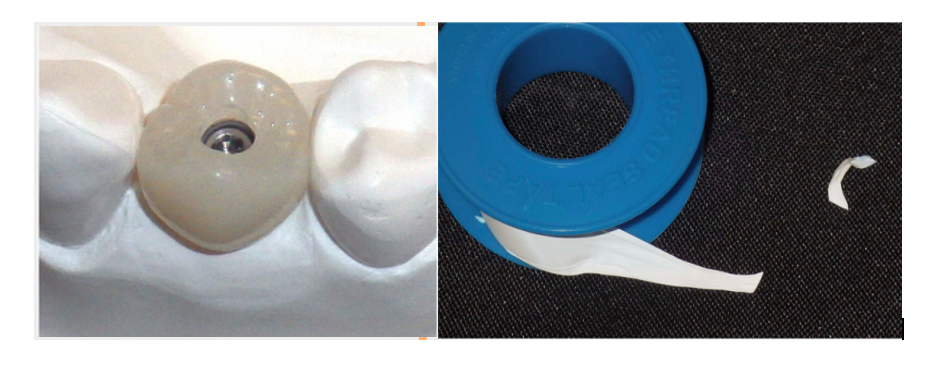AM I USING THE WRONG MATERIAL TO FILL SCREW ACCESS HOLES IN SCREW-RETAINED RESTORATIONS?
Randolph R. Resnik, DMD, MDS
In implant dentistry today, the technique selected for filling screw access channels in screw- retained prostheses is highly dependent upon the clinician’s preference. Unfortunately, there exists very little evidenced based data on the ideal materials and suggested protocol. Various materials are being utilized to fill access holes including cotton pellets, gutta-percha, polytetrafluoroethylene (PTFE) tape, cavit, and wax. According to a dental school survey, 59 % of prosthodontic residency programs and 77% of restorative clinics use cotton pellets to cover the screw access opening and protect the head of the abutment screw under the final restoration.
PROBLEM:
The disadvantage of many of the above-mentioned materials is the increased susceptibility for bacterial and fungal adhesion. The contamination may also be initiated from bacteria trapped during prosthetic insertion. However, numerous studies have shown a significant bacterial colonization at the implant-abutment interface and within the internal implant cavity which leads to peri-implant inflammation and marginal bone loss. 2 Because of the micro-gaps at the implant-abutment connection, a reservoir for progressive bacterial colonization of anaerobic proteolytic microorganisms may result. In addition, the continued presence of streptococci and the fungal pathogen Candida albicans leads to the production of malodor (offensive odor). A recent study confirmed the association between the internal colonization of pathogenic bacteria and resultant peri-implant bone loss.3
IDEAL MATERIAL: Raab et al. evaluated numerous materials for the susceptibility of bacterial and fungal growth adhesion. They concluded that the worst screw-channel filling material is cotton pellets because of the high adhesion of microorganisms. This was attributed to the untextured fiber structure of the pellets, which entraps the bacteria and allows fungal growth. The most ideal material was determined to be PTFE (plumbers tape), which was shown to have a very low adhesion rate. In addition, PTFE tape has the advantages of being condensable, sterilizable, and is easily removed.
- Obtain commercial PTFE tape from the hardware store.
- Autoclave multiple small pieces (~0.5cm).
- Prior to the abutment screw placement, irrigate the screw access hole (internal aspect of the implant body) with 0.12% chlorhexidine and a 1.0cc syringe.
- Verify complete seating of the abutment or crown with a radiograph and torque to the manufacturer’s specifications.
- Cut and place a small piece of sterilized PTFE tape in the access chamber and condense leaving approximately 3 mm of space.
- Apply an appropriate composite bonding agent on the walls of the screw access as well as the PTFE plug.
- Fill the access hole with an opaque composite, smooth surface with a cotton applicator/bonding agent, and then polymerize.
- Verify occlusion as per the implant protected occlusion protocol.
- Tanimura, Rémy, and Shiro Suzuki. "Comparison of access-hole filling materials for screw retained implant prostheses: 12-month in vivo study." International Journal of Implant Dentistry3 (2017): 1-8.
- Raab, Philipp, et al. "Dental materials and their performance for the management of screw access channels in implant-supported restorations." Dental Materials Journal 36.2 (2017): 123-128.
- Schoenbaum, Todd R., Chandur Wadhwani, and Richard G. Stevenson. "Covering the implant prosthesis screw access hole: a biological approach to material selection and technique." Journal of Oral Implantology 43.1 (2017): 39-44.


